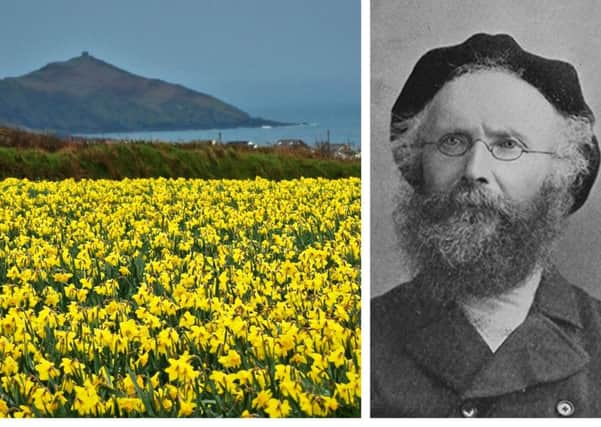The blooming story of Peter Barr, Govan’s ‘daffodil king’


But Peter Barr, from Govan, remained driven by his one passion - the humble daffodil.
As the bold yellow blooms light up vases and verges everywhere, it is worth remembering the efforts of Barr in popularising the flower. It was his never ending quest to bring the bloom - then sometimes known as the daffydowndilly - home from hillsides and rockfaces all over the world.
Advertisement
Hide AdAdvertisement
Hide AdWhen in his seventies, he started travelling through South America, Japan and China in search of the flowers with the mission expected to take him three years. It took him seven in the end.
At the time, daffodils were considered unfashionable - some say because of Queen Victoria’s dislike for the colour yellow - but Barr, who became interested in horticulture after tending his dad’s tulips on the south side of Glasgow, became intrigued by narcissus after learning that they way it was catalogued was far from complete.
In the end, his nursery at Long Ditton in Surrey nurtured some 2,000,000 daffodils with newspapers urging their readers to catch a train to witness the gorgeous yellow show that was put on by 120 separate varieties
Many of these varieties had been developed by Barr, who married and had at least seven children, with cross breeding and refinement of the flower becoming his major concern.
The first white trumpet daffodil was named in his honour and put on sale at £50 a bulb in 1903 - the equivalent of more than £5,000 today.
A newspaper article in 1898 reported on Mr Barr’s far-flung flower hunting odysseys.
It said: “In Spain...he had been sleeping in the open air under rocks, and was naturally travel stained.
“Like Sancho Panes, be rode a donkey. His chief garment was a blanket, which covered himself and much of his steel.
Advertisement
Hide AdAdvertisement
Hide Ad“His appearance was suspicious, and his position awkward, for he could not speak Spanish.
“Luckily he had a passport., and was, after some delay, permitted to continue his search for new daffodils.
“In that pursuit he has been successful on many occasions in Spain and Portugal, where the daffodil is more at home and shows a greater number of varieties than anywhere else.”
An entry from Barr’s diary dated June 17, 1887 details a 5am start on horseback with his transport abandoned when it could go no deeper into the Pyrenees.
Barr and his companion, named as Passet, started on foot over the snow with the Govan man noting the “splendid views of valleys and mountain peaks”.
He added: “Further down we were challenged by soldiers who wished to know who I was. In the distance was a posse of soldiers awaiting our approach so we got a public and military reception at Baucharo. It had been reported that Torelle a famous bandit was about to enter Spain and I was suspected of being the man.
Following his death in September 1909, newspapers recalled his “romantic rise is fame and fortune”.
One of 12 brothers, Barr was born in 1826 in Govan, then a small village on the banks of the River Clyde which was dominated by the weaving industry and where his father owned a muslin-weaving mill.
Advertisement
Hide AdAdvertisement
Hide AdIt was from his father that his love for flowers grew, saying in an interview in later life that he was “born within a few yards of a tulip bed, and I have been amongst flowers ever since”.
Barr first worked as a weaver’s assistant at his father’s mill but then took a job as an errand boy in a Glasgow seed shops. He moved to Newry, Northern Ireland before heading to the south of England,
In 1861, he went into partnership with Edward Sugden in Covent Garden and then set up a number of small nurseries in Tooting - where a blue plaque now remembers the Scot - before buying up 25 acres in Surrey.
In later life, settled in Dunoon where his garden here was devoted to primroses and hellebores. By this time, his work with the daffodil was simply done.
Since 1912, the Royal Horticultural Society has awarded the Peter Barr Memorial Cup for good work in the fiedl of daffodils.
John David, Head of Horticultural Taxonomy at the RHS, says: “There is no doubt that Peter Barr had a major impact on daffodils in horticulture.
“He sought out old collections of daffodils from breeders and brought them together in his nursery – creating a collection of over 400 varieties, and was in a sense an early pioneer in cultivar conservation.
“He devised a system for classifying the cultivated varieties, published in his nursery catalogues, which was adopted by the RHS as the basis for the classified lists we issued from 1908 onwards.
Advertisement
Hide AdAdvertisement
Hide Ad“These lists established the RHS as the authority on naming of daffodil varieties and so in 1955 the RHS became the International Cultivar Registration Authority for Narcissus.
“So Barr’s work could be said to be the foundation of the compilation of over 30,000 different daffodil names we hold today.”
